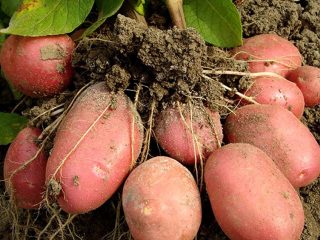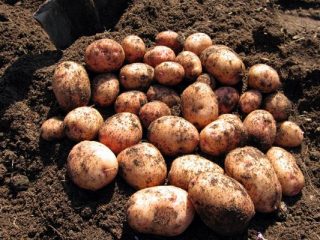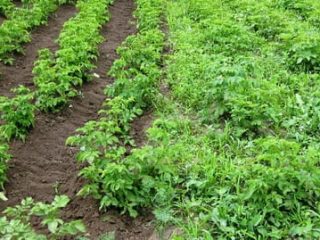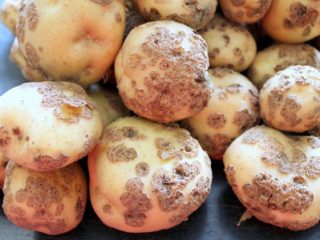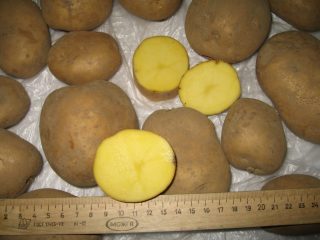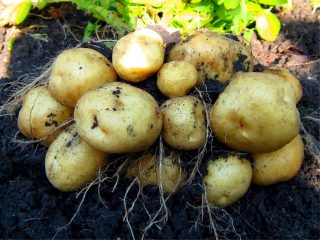Content
Nandina potatoes, which appeared on sale relatively recently, immediately attracted the attention of amateur gardeners and professional farmers due to the very early ripening of the crop. It also has other advantages that contributed to the rapid growth of popularity of the variety not only in its homeland, but also in other countries. Plants successfully adapt to different climatic conditions; they do not require any specific care.
History of origin
The Nandina potato was bred about ten years ago by breeders of a very famous agricultural company from Germany, EuroPlant Pflanzenzucht GMBH (or, for short, simply “EuroPlant”). An application for its registration in the Russian Federation was submitted in 2012, and the necessary variety tests were completed fairly quickly. Since 2015, it has been listed in the domestic State Register of Selection Achievements.
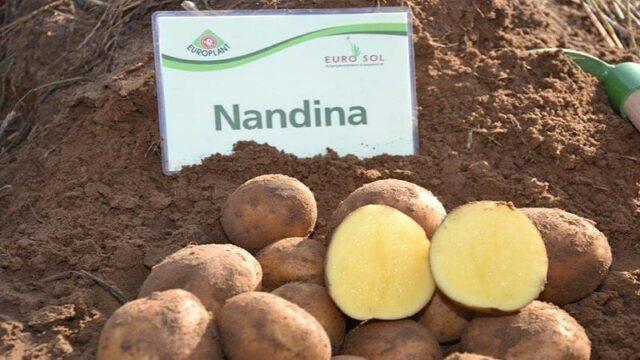
Elite seed potatoes are one of the main “specializations” of the originator of the Nandina variety
Description of Nandina potato variety
The appearance of Nandina potato bushes is typical for the crop. A layman will definitely not be able to distinguish them from other varieties and hybrids. The tubers look quite presentable, which undoubtedly attracts the attention of amateur gardeners and farmers when choosing a variety.
Bush
The bushes reach 55-60 cm in height. The root system is well developed, the stems are quite powerful and semi-erect. The leaves are large, their type varies from completely open to intermediate, the shade - from light, almost salad, to rich green. Medium-sized flowers with pale lilac petals
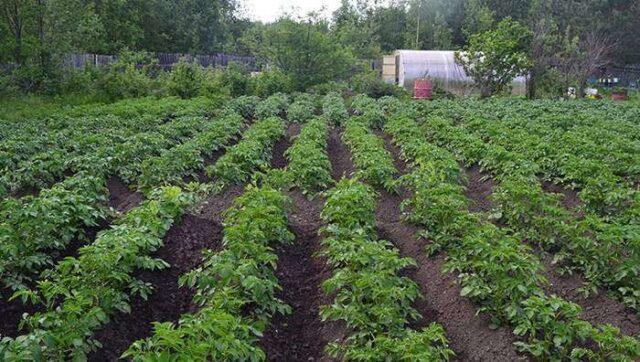
Nandina potato bushes rarely “fall apart”
Tubers
The tubers have a regular round-oval shape. Their weight is 72-132 g, “trifles”, unsuitable for storage and inconvenient for cleaning, are practically absent from the “nests”.
The skin of the tubers is yellowish-beige, thin, but quite durable. This ensures good shelf life and transportability. Most of the “eyes” are small and superficial, but there are also slightly recessed ones. The pulp is creamy-yellow, elastic, not watery, with a noticeably “oily” consistency, retaining color and shape after heat treatment. The average starch content (12.8-15%) “helps” with this.
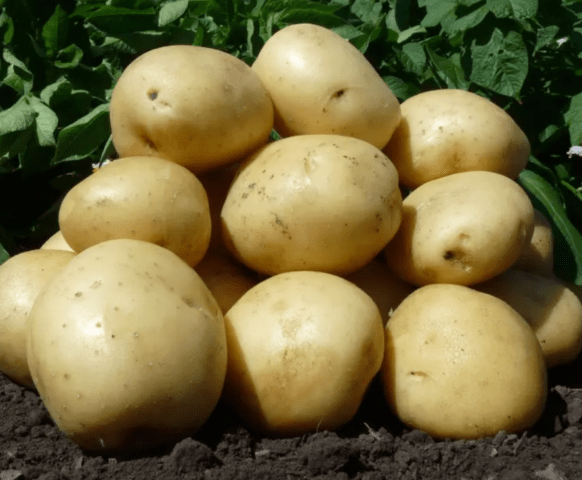
The percentage of marketable tubers is 77-93%
Characteristics of Nandina potatoes
Nandina is an ultra-early table potato. But in order not to make a mistake in choosing a variety for your own personal plot, it is necessary to evaluate not only the timing of crop ripening, but also other important characteristics.
Taste qualities of Nandina potatoes
Taste qualities are officially recognized as “good” and “excellent”. This is not typical for early varieties. According to the culinary classification, it belongs to type AB.Tubers are suitable for boiling, frying, baking, stewing. They can be used to prepare any soups, complex side dishes, and salads.
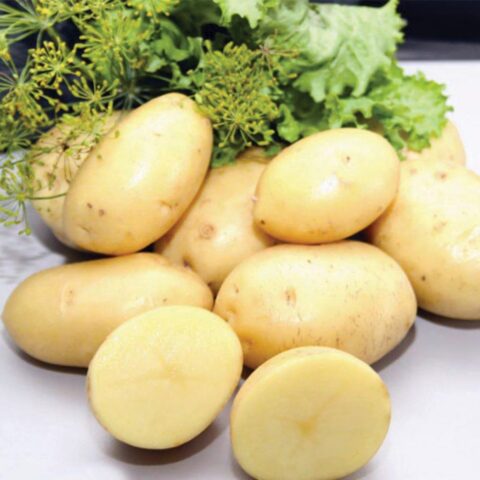
After heat treatment, Nandina potato pulp retains its characteristic color
Ripening time
It takes 40-45 days for tubers to ripen in central Russia from the moment “mass” shoots appear in the beds. In the southern regions, this period may be reduced by another 5-7 days. In both cases, the variety is naturally classified as ultra-early.
Productivity
The yield of Nandina potatoes, determined during variety trials conducted in Russia, is 145-320 centners per hectare. This approximately coincides with the performance of the varieties chosen as the standard - Gloria and Bryansk early.
However, the yield varies greatly not only depending on the region of cultivation, it is also influenced by the type of digging that is carried out. The volume of the first “experimental” harvest was 80-180 c/ha: this is significantly (25 c/ha) higher than that of the “standard” variety Zhukovsky early. During the second digging, the indicators of Nandina potatoes are 115-235 c/ha, the “standard” Udacha is 55 c/ha less.
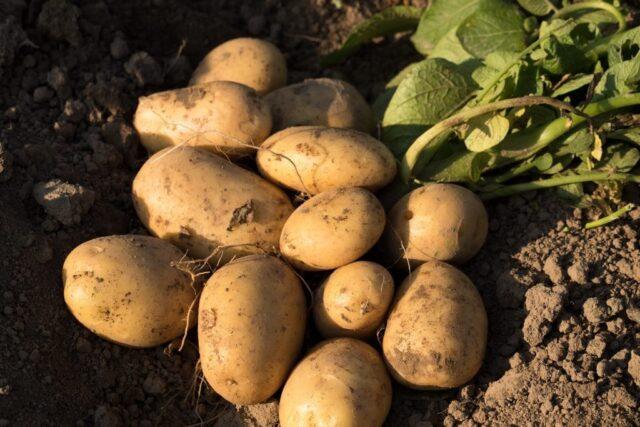
The variety demonstrated record yields (almost 330 c/ha) in the Perm region, surpassing Pushkinets potatoes by 108 c/ha
Growing regions
Officially, Nandina potatoes are recommended for cultivation in the European part of Russia.However, the experience of gardeners who “conducted experiments” in areas with a more severe climate indicates that Nandina potatoes are quite suitable for the Urals, Siberia, and the Far East, if you do not rush into planting. Thanks to the rapid ripening of tubers, gardeners have time to harvest at least one harvest even in a short, cool summer.
Disease resistance
The Nandina variety has “innate” immunity against potato cancer, a bacterial disease for which there are no treatments yet. Plants are not affected by golden cyst nematode. Also in the description of the originator it is mentioned that it is resistant to several types of mosaic and leaf curl viruses. Nandina potatoes are also rarely affected by pathogenic fungi (for example, scab), the only exception being late blight, which affects both the above-ground part of the plant and the tubers.

Tubers affected by late blight are immediately thrown away; they cannot be eaten or stored.
Advantages and disadvantages
The very early ripening of Nandina potatoes allows for two harvests per season. In the southern regions, if the beds are provided with high-quality care, their number generally increases to three.

If you plan to boil or bake Nandina potatoes with their skins on, you can dig them out even slightly unripe
Pros:
- very early ripening;
- the opportunity to get 2-3 harvests per season;
- the yield is quite high for an early variety;
- simple, “basic” planting care;
- the presence of immunity against incurable diseases typical of the culture, a dangerous pest (nematode);
- good transportability;
- a small percentage of potatoes that spoil during harvest storage;
- external presentability of tubers, a minimum of “trifles”;
- good taste;
- culinary versatility.
Minuses:
- the tendency of the above-ground parts of the plant and tubers to be affected by late blight;
- low cold resistance.
Landing Features
Planting Nandina potatoes should never be rushed due to its low cold tolerance. Return frosts after planting, if the beds are not covered with black plastic film, will lead to rotting of most of the tubers. And when the temperature drops below -4 °C, they die, despite the shelter. When determining the timing of planting, it is necessary to take into account the long-term weather forecast and measure the soil temperature in advance.
The highest yields of Nandina potatoes are harvested by planting them in well-cultivated soil that combines nutritional value and looseness. Equally important for the rapid ripening of tubers is warmth and sunlight - it is advisable that the bed is located in an open place.
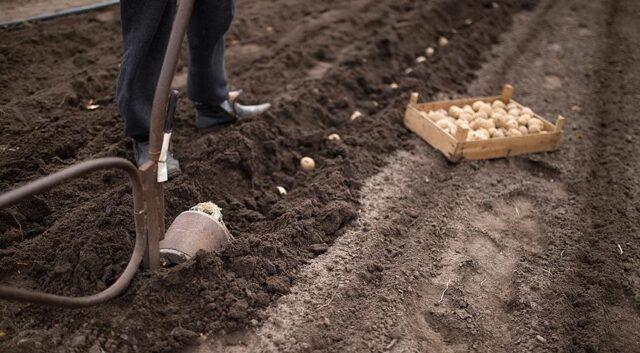
Do not compact the substrate too hard after planting the tubers.
The bed is dug up in the fall, adding humus and other fertilizers as needed, getting rid of debris. Nandina potatoes are planted according to the standard scheme, leaving 30-35 cm between adjacent tubers, and 70-75 cm between rows. The depth of the hole is 8-15 cm, depending on the “heaviness” of the substrate. If desired, fertilizers or folk remedies are placed at the bottom to repel pests.
Pre-planting preparation of Nandina potato tubers necessarily includes its germination. Otherwise, the variety ceases to be ultra-early.To prevent late blight, tubers are sprayed with a solution of a suitable fungicide immediately before planting. There are also folk remedies with antifungal properties, they are also suitable.
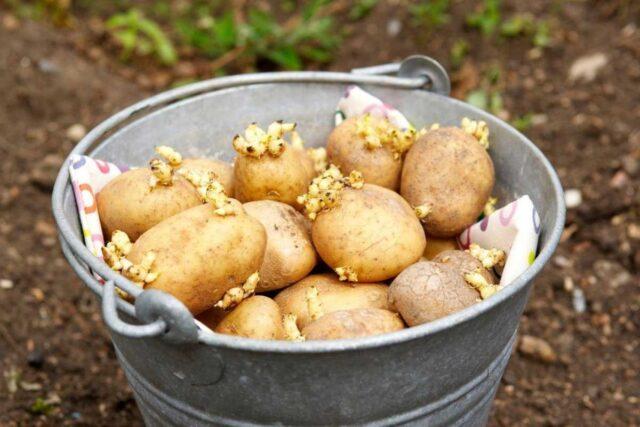
Germination of planting tubers takes 3-3.5 weeks
Care instructions
Nandina potatoes are undemanding in care. Agricultural technology is limited to standard activities:
- Watering. Most often, Nandina potatoes make do with natural precipitation. But if there is no rain for more than ten days, it is hot, and the beds need to be watered. There are also stages of development when bushes especially need water - 7-10 days after the emergence of mass shoots, at the time of bud formation and immediately after flowering.
- Hilling. Nandina potatoes are hilled when the stems reach a height of 12-15 cm and after about two weeks.
- Feeding. If the bed is prepared in accordance with all recommendations, and fertilizers are added to the holes during planting, you can do without fertilizing. Otherwise, 3-4 days after emergence, Nandina potatoes are provided with nitrogen, and complex fertilizer is applied immediately after flowering.
- Disease prevention. The fungus that causes late blight becomes active in rainy, cool weather. To prevent infection, Nandina potato bushes are treated every 7-10 days with a solution of a fungicide suitable for use at this stage of the growing season. Insecticides may also be required to protect against the Colorado potato beetle and other pests. In order to promptly notice their attack on the bushes, it is recommended to inspect the beds weekly.
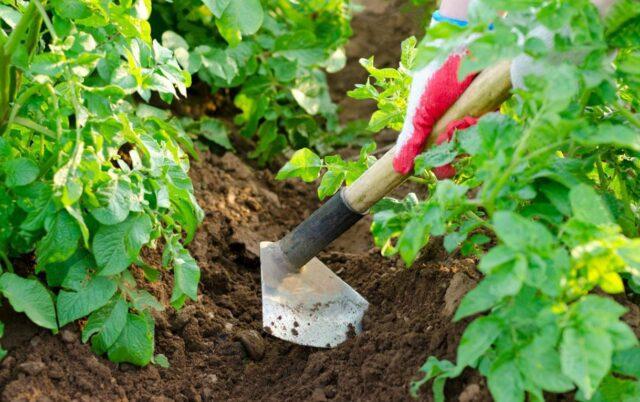
Hilling is necessary for the proper development of the root system
Harvest and storage
The first harvest of Nandina potatoes in the south is harvested in the 20th of June, in central Russia - in the first ten days of July. The last one is at the end of August. The ripening of tubers is “signaled” by drying stems lying on the bed. Both manual and mechanized cleaning are possible.
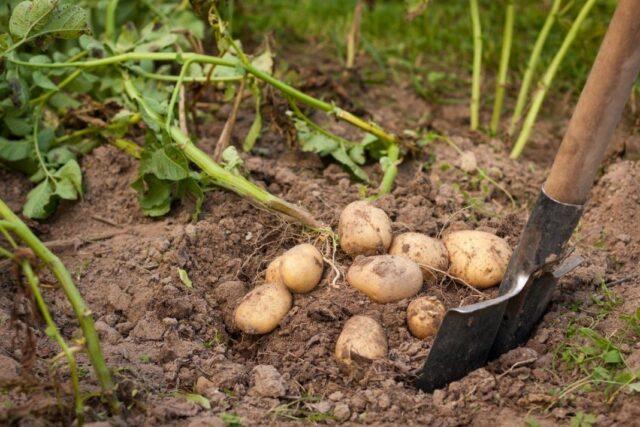
It is advisable to dig up potatoes when it is sunny and not too hot outside.
Before storing, Nandina potatoes are sorted and dried for 7-10 days. The method and place do not matter; it is more important to provide the tubers with suitable conditions:
- temperature 2-4 °C;
- air humidity 70-80%;
- lack of light and drafts;
- good ventilation.
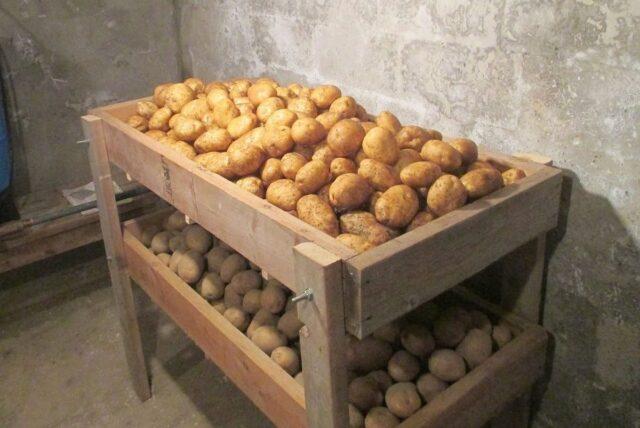
Nandina potatoes are not suitable for long-term storage
Conclusion
Nandina potatoes are an ultra-early variety; the very short ripening time of the tubers allows you to harvest 2-3 crops per season. It is suitable for both amateur gardeners and professional farmers. Plants do not require particularly complex and time-consuming care and can adapt to different cultivation conditions. In order to regularly harvest abundant harvests, you need to learn in advance about the important nuances of agricultural technology and pre-planting preparation.
